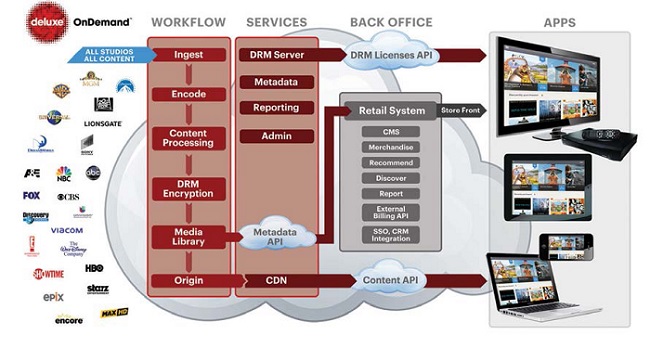Deluxe Melds Metatags and Multiplatform

Gary Arlen
LOS ANGELES— During post-production, Deluxe Entertainment puts a metatag on every scene when a character drinks a beverage, drives a car or puts on a pair of shoes. If specific product brands appear in a scene, they also get a metatag.
Months or years later, when the show appears on a screen—be it living-room flat-panel, mobile handset or anything in between—the distributor of that video asset will be able to sell a commercial or create a “time-in,” including a second-screen promotion triggered by metadata, to an appropriate advertiser.
That’s just one of the multiscreen opportunities that Chris Rittler of Deluxe Digital Distribution envisions for the evolving integrated content and distribution channels that his nearly century-old company serves.
“We’re making certain that our cloud catalog can be distributed onto any system,” said Rittler, who is senior vice president of sales, business development and marketing at the Deluxe unit. “This is where the value lies. Distributors and advertisers want [this metadata] in content catalogs,” focusing on the increased importance of future-proofing multiplatform material.

ENHANCED SEARCH
Metadata accompanying the original video files also provides enhanced search recommendations, which media companies use for dynamic ad insertion, Rittler said.
“Many of our customers, since they are going beyond the set-top box, want enhanced metadata,” he said, describing several ways in which Deluxe has handled that capability. “We’ve automated our metadata,” because customers have different needs. For example, TV networks or online video services may want to highlight individual actors for a theme series, and the metadata helps single out those performers. Rittler also explains that review and ratings metatags can help programmers select programs on a variety of scales, including (as he notes with a chuckle) the “Rotten Tomatoes” critiques.
“We’ve invested in enabling all kinds of distributors to get their content to all kinds of platforms in both linear and video-on-demand formats,” Rittler said. He emphasizes the interweaving of the emerging platforms: “The combination of getting content to screens for both VOD and linear is hugely important.”
Deluxe on Demand clients include ABC, CBS, NBCUniversal, Fox, Viacom and Discovery plus premium cable channels such as HBO, Showtime, Starz and Epix. The company also works with its legacy studio clients such as Sony, Warner Bros., Universal and 20th Century Fox along with many other studios.
Rittler acknowledges that the diversification of today’s market makes the metatagging task so complex, especially with the goal of assuring that content reaches various screens as networks and carriers expect. While cable distribution is “very standardized,” he said—either 15 Mbps for HD or 3.5 Mbps for SD, the multiscreen universe requires 50 different formats, or more.
Deluxe’s multiscreen solution architecture.
And even the 15 Mbps format is not a simple matter, Rittler said. “You have to look at resolution, screen size, audio and a number of other variables” to assure that viewers see the program the way the producers and distributors intended to.

Adding to the current complexity is that, as Rittler sees it, “distributors’ engineering teams may think their content looks better on different devices. It comes down to bitrates,” he adds, noting that “you’ll see it differently” on an iPad Air or living room flat panel displays.
STANDARDS NEEDED
Further complicating the encoding task is the lack of digital rights management standards, he said.
Deluxe has developed a workflow process as it prepares content for multiplatform distribution. Its video catalog now includes 40,000 titles, and the company is adding “thousands more every month.”
The first step is encoding content, for example compressing 200 MB of content into a 9 MB package. Then it is “chunked up” into a packager, such as Smoothstream. Finally, the show is encrypted.
The lack of DRM standards represents merely one of the challenges as video content is prepared for multiplatform distribution, Rittler said. One of the reasons that there are no standards is that “technology is changing so fast between devices, DRM and encoding capabilities.” For example, he points out that there are only a handful of distribution platforms in the cable world (such as Arris and Seachange), but there are many more platforms for over-the-top channels.
“No one can keep up,” he said. “We say [to clients] that with what we’ve done, we will keep up with it for you. We call it a ‘content factory in the cloud,’ and we use it to keep up with the changes in specifications.... As content is flowing, it all goes though our system. As specs change, we can retool the system on the fly.”
Deluxe also provides hosting and content delivery network services for its customers, providing what Rittler calls “integrated service” to feed the final-leg distribution systems. Deluxe works with other CDNs such as Akamai and Limelight to assure that content reaches clients in the format needed.
For media companies, a core workflow feature is the “media library” function that applies metadata APIs (application programming interface) to push content through the appropriate retail channels. For example, some clients want UltraViolet information integrated into the identification.
Deluxe is adding multiscreen capabilities as well, according to Rittler. Tweets are often part of the mix of information about a show, so Deluxe is feeding data from social media into its material and then assures that such tweets play on any viewer device.
The company is also preparing to develop data-gathering options from mood sensors and other devices that are part of the evolving “Internet of Things” process.
“When you look at the developments in [content] search based on metadata it makes sense,” Rittler said. This rich metadata is enabling program selection and recommendation based on moods affected by what you watch, he suggests. He believes that this is an area where “we can provide viewers with an enhanced content service.”
“We want to connect viewers to content,” Rittler said. “Now we can make sure that viewers can find the content that interests them. It’s a big challenge.”
Gary Arlen tracks media and multiplatform services from Arlen Communications LLC,www.arlencom.com.
Get the TV Tech Newsletter
The professional video industry's #1 source for news, trends and product and tech information. Sign up below.
Gary Arlen, a contributor to Broadcasting & Cable, NextTV and TV Tech, is known for his visionary insights into the convergence of media + telecom + content + technology. His perspectives on public/tech policy, marketing and audience measurement have added to the value of his research and analyses of emerging interactive and broadband services. Gary was founder/editor/publisher of Interactivity Report, TeleServices Report and other influential newsletters; he was the long-time “curmudgeon” columnist for Multichannel News as well as a regular contributor to AdMap, Washington Technology and Telecommunications Reports; Gary writes regularly about trends and media/marketing for the Consumer Technology Association's i3 magazine plus several blogs.

